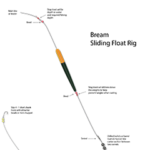13.2K
Sliding Float Rig
Suitable for bass, pollack, wrasse, coalfish, garfish and mackerel.
Sliding Float Rig Components
Main Body
2 x 3mm Beads
2 x Small Swivels
Drilled bullet or barrel lead
1 x Float; size depends upon the weight being supported including the bait
1 x 10 – 20lb BS leader material, length depends on depth to be fished
1 length of Powergum
Snood
1 x 600 to 900mm length 10 – 20lb BS clear nylon or fluorocarbon snood
1 x 1 to 4/0 hook; size of hook will depend upon target species and bait size
The Rig Body
- Tie on the leader onto the reel line using double uni knot or spider hitch to Albright knot if using braid for main line.
- Thread the following components onto the leader – Bead / Sliding Float / Bead then tie on a swivel.
- Tie a length of heavier nylon, 150mm to the swivel.
- Thread the barrel or bullet lead(s) onto this nylon them tie on the second swivel.
- Tie the hook to the snood, then tie the other end of the snood to the swivel.
- Approximately 600mm above the weight tie a Powergum stop knot on the snood side of the lower bead.
- Above the top bead tie a Powergum Stop Knot at a distance which allows the bait to fish at the appropriate depth.It may be counter intuitive but the stop knot will flow through the rod guides easier if the tag ends are left at around 25mm rather than being trimmed short.Remember to allow for the fact that the hook will be fishing below the weight.
- If live baiting for bass etc. you may wish to substitute a treble hook for the single.
By changing the hook set up this float rig can be successfully used for bream or plaice from the boat or shore.
Click on image for larger version
Several variations can be seen in the gallery below.
There are numerous sources of terminal tackle both locally and on-line, here are a few suggestions –
Facebook Comments Box






